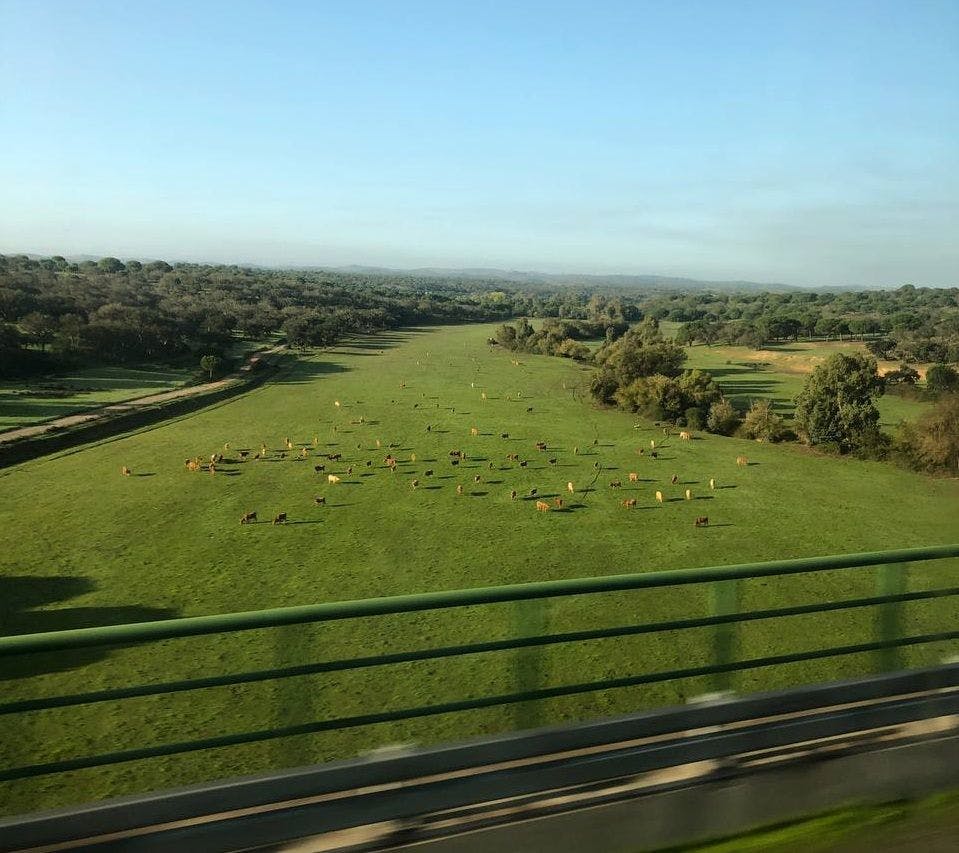
Climate and weather in Luxembourg
Yellow alerts from Meteolux, floods in spring and occasional miracle snow that you will see immediately on the Instagram of every self-respecting Luxembourger. The weather in Luxembourg can be unpredictable, but predictably you'll learn all about the climate in the country from our article.
Luxembourg has a mild climate with moderate seasons and temperatures. It rains a lot here, and it's always humid. The climate in Luxembourg is affected by the Atlantic Ocean and west winds, which bring humid air and clouds. Luxembourg City has an average temperature of 0°C in winter and 25°C in summer. It rains all year, but it is wettest in May and June. Snow is common in winter but melts fast.
Climate in the Grand Duchy of Luxembourg
Luxembourg does not have a clear climatic definition, you can think. Its climate can be conditionally called moderately marine. It is best described by mild winters and not extremely hot summers, which is confirmed by the average annual temperatures: normally they range from -2.6 °C to 21.6 °C.
The continental climate of the Eastern European plains confronts it and affects the general rules. It's sunny in summer, especially in July. Luxembourg enjoys an Indian summer in September and October. An Indian summer is warm and dry weather in late autumn or early winter.
Winter temperatures here range from +3°C to -6°C which is not too bad, if you have a couple of warm coats. The coldest month of the year is January. The climate in the Grand Duchy is strongly influenced by the country's terrain. For example, temperatures in the north are 2 to 3 degrees lower than in the south, due to the mountainous terrain in the north and the Luxembourgish plateau and plains in the south.
Climate in Luxembourg's regions
The Grand Duchy is divided into 5 natural regions: they are Guttland, Éislek, Minett, Moselle, and Mullerthal. Each of them contains different communes, and various touristic destinations, as well as different natural resources.
This region is located in the central part of the country and is best described by gently rolling hills and fertile agricultural land. It is home to several small towns and villages, as well as the country's capital city, Luxembourg City. Guttland is also known for its dense forests and numerous hiking trails.
Good land
Guttland is literally translated as «good land». The topography is mostly flat: meadows, fields, vineyards, and forests. But Guttland is more urbanized than Éislek. Consequently, there are fewer forests and they grow in the northern part of the region.
The climate here is softer, with fewer temperature fluctuations. That means softer winters with almost no snow, and warmer summers.
Also known as the Oesling, this region is located in the northern part of the country and is characterized by rugged hills, dense forests, and deep valleys. It is home to several small towns and villages, as well as the town of Clervaux and its famous castle. Éislek is also known for its natural beauty, including the Our River and the Ardennes forest.
The climate in Éislek is more severe than in the rest of the country. The northern part of the region has the coldest and most humid weather in all of Luxembourg. Ardennes, a mountain chain and a land of vast forests lie on the border of France, Belgium, and Luxembourg. It often snows in the winter here.
Forest lands
In comparison with Gutland, the region is mostly hilly and more heavily forested: birch, oak, and pine forests can be great places to enjoy nature here.
This region is located in the south of the country and is described by a landscape of former industrial sites and mining towns. It is home to several important historical and cultural landmarks, including the city of Esch-sur-Alzette and its steelworks, the National Mining Museum in Rumelange, and the Fond-de-Gras railway museum.
This region is located in the east of the country and is full of steep vineyards and picturesque villages along the Moselle River. It is home to several important wine-producing towns, including Remich, Grevenmacher, and Wormeldange, as well as the historic city of Trier, located just across the border in Germany.
Also known as Luxembourg's Little Switzerland, this region is located in the east of the country and is characterized by a landscape of rocky cliffs, dense forests, and winding rivers. It is home to several scenic hiking trails, as well as the town of Echternach and its famous dancing procession.
The biggest areas of natural regions in Luxembourg are Éislek and Guttland. Éislek includes 3 northern cantons Clervaux, Vianden, and Wiltz. It also partly includes Dikirch and Rodange. Guttland includes Echternach, Grevenmacher, Remich, Capellen, Esch-sur-Alzette, Luxembourg, and Mersch.
Corn fields and cows
The area between Éislek and Guttland is a major agricultural region of the country due to its rich and varied soil.
What weather to expect in Luxembourg during different seasons?
Luxembourg has four distinct seasons, each different. Demi-seasons are rainy and changing, while mild winters can sometimes surprise you with decent amount of snowing. Summer, though often not too hot, is sunny and warm.




Overall, if we are talking about climate change, affecting the whole planet, the climate in Luxembourg is changing too, with temperatures increasing and rainfall patterns becoming more unpredictable. This has significant implications for agriculture, water resources and the environment in Luxembourg.
Winter in Luxembourg
Winter season is characterised by cold temperatures and occasional snowfall. Average maximum temperatures during this time range from about 4°C to 7°C, while average minimum temperatures range from about -1°C to 2°C. The average number of hours of sunshine per day during winter ranges from 1 to 3 hours a day, depending on the month. Winter is also the rainiest season in Luxembourg, with an average of 16 to 18 rainy days per month.

Luxembourg's schools usually have a winter break that lasts for about two weeks, starting around December 23rd and ending in early January. This time is used by many families to spend time together and travel.
| Celebration | Another name | Date in 2024 |
| Christmas | Noël | 25 December |
| St. Stephen's Day | Saint-Etienne | 26 December |
| New Year Day | Nouvel An | 1 January |
| Carnival | Carnival | 11 to 19 February |
| Buergbrennen | Buergbrennen | 2 March |
There are several holidays in winter in Luxembourg
Overall holiday season generally begins in mid-December and lasts until early January. The main winter holiday in Luxembourg is Christmas, which is celebrated on December 25th.
Spring in Luxembourg
Spring in Luxembourg is mild in terms of temperatures, with occasional rainfall. Average maximum temperatures during this time range from about 9°C to 16°C, while average minimum temperatures range from about 2°C to 7°C. The average number of hours of sunshine per day during spring ranges from 4 to 6, depending on the month. Spring is also a relatively rainy season in Luxembourg, with an average of 12 to 14 rainy days per month.

We should add, that flowers start blooming earliest at the end of February: you can see small crocuses all around the city. Then in late March, all trees start to bloom and Luxembourg starts its spring carnival.
| Celebration | Another name | Date in 2024 |
| Bretzel Day | Bretzelsonndeg | 10 March |
| Easter Monday | Lundi de Pâques | 1 April |
| Labor Day | Fête du Travail | 1 May |
| Europe Day | Journée de l'Europe | 9 May |
| Ascension Day | Ascension | 13 June |
| Trinity Monday | Lundi de Pentecôte | 20 May |
Easter in Luxembourg
In 2024, Easter Sunday in Luxembourg will fall on March 31st, and will be followed by Easter Monday on April 1st. Learn more about this colourful event in our article.
Summer in Luxembourg
This warm season is characterized by high temperatures and occasional thunderstorms. Average maximum temperatures during this time range from about 21°C to 24°C, while average minimum temperatures range from about 12°C to 15°C. The average number of hours of sunshine per day during summer ranges from 7 to 9, depending on the month. Summer is also a relatively dry season in Luxembourg, with an average of 7 to 8 rainy days per month.


Luxembourg national holidays – Blog Article
The summer months are also a popular time for many people to take their vacations and travel. Many families choose to spend time together by going on holiday, either within Luxembourg or to other destinations around the world.
| Celebration | Another name | Date in 2024 |
| Mother's Day | Mammendag | 8 June |
| National Day of Luxembourg | Fête nationale | 23 June |
| Assumption Day | Assomption | 15 August |
| Annual fair | Schouberfouer | 23 August to 11 September |
In July and August, several music festivals take place in Luxembourg, including the Rock um Knuedler festival in Luxembourg City and the Blues 'n' Jazz Rallye in Kirchberg. These festivals attract musicians and music lovers from around the world.
Autumn in Luxembourg
Luxembourgish autumn is best described by mild temperatures and occasional rainfall, with the leaves on the trees turning vibrant colours. Average maximum temperatures during this time range from about 16°C to 12°C, while average minimum temperatures range from about 8°C to 3°C. The average number of hours of sunshine per day during autumn ranges from 2 to 5, depending on the month. Autumn is also a relatively rainy season in Luxembourg, with an average of 13 to 15 rainy days per month.

Autumn is also a great season in Luxembourg to enjoy the beautiful fall foliage in Luxembourg. The changing colours of the leaves make for stunning scenery, and many people enjoy taking hikes or bike rides through the forests and countryside to enjoy the autumn.
| Celebration | Another name | Date in 2024 |
| Grape Festival | Drauwen- a Wäifest | 6 to 8 September |
| Father's Day | Father's Day | 6 October |
| Halloween | Halloween | 31 October |
| All Saints' Day | Toussaint | 1 November |
One of the most important autumn celebrations in Luxembourg is the Grape and Wine Festival in Grevenmacher. Another harvest festival in Luxembourg is the Kiermes, which is celebrated in many villages and towns throughout the country in September and October. Luxembourg also celebrates Halloween, which has become an increasingly popular holiday in the country in recent years.
Luxembourg weather forecasts and most accurate apps
You can find information on the weather forecast in Luxembourg from various sources, including different meteorological services that work worldwide or locally.
Join our Telegram for daily weather and news digests

If you're looking for up-to-date weather information in Luxembourg, you might want to check out the Meteolux mobile app. The app offers a range of features to help you stay informed about the latest weather conditions.
With the Meteolux app, you can access current weather conditions, hourly forecasts, and 7-day forecasts for Luxembourg. The app provides information on temperature, wind speed and direction, humidity, air pressure, and more. You can use this information to plan your activities and stay safe during severe weather events. In addition to its basic weather features, the Meteolux app also provides alerts for severe weather events, such as thunderstorms, heavy rain, and snow. You can customize notifications for specific weather events that are important to you.
Where to download?
The mobile application is available for download in Google Play and App Store.
A collaboration between Meteolux and Belgium resulted in a special mobile application, that shows the weather in Belgium and the Grand Duchy. The app provides up-to-date weather information, including current conditions, hourly and 7-day forecasts, and alerts for severe weather events in both these regions.
The app also provides information on air quality, UV index, and road conditions. Users can customize notifications for specific weather events and locations, and the app is available in both French and German.
In order to see the weather in Luxembourgish commune, go to the app settings, choose "Communes", and, with the + symbol at the top right of your screen, enter the name of the Luxembourg municipality of your choice.
Where to download?
The mobile application is available for download in Google Play and App Store.
Despite the fickle weather, Luxembourg is a great place to live. As they like to say, there is no bad weather, just inappropriate clothing. So stock up on an umbrella, raincoat and sun hat, and leave the rest to nature.
Frequently Asked Questions (FAQ)
What is the climate of Luxembourg feels like?
What are the main natural regions of Luxembourg?
What is the average weather in the capital of the country?
Source: luxembourg.public.lu, meteo.be, meteolux.lu
We took photos from these sources: Matthew Henry on Unsplash, Luxtoday archive photos